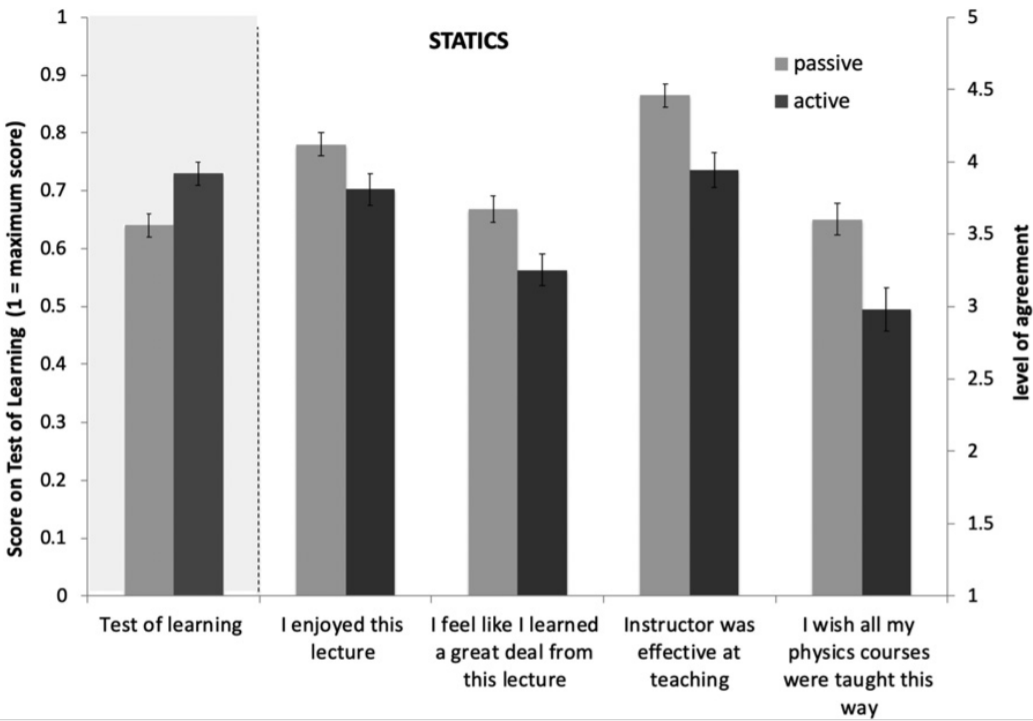Earlier in September I read an article in Inside Higher Ed on this problematic of active learning versus lecture. I loved it and found the conclusion of the article very interesting, but as I am always skeptical of what is reported from a scientific article I decided to go ahead and read the paper myself … bottom line it pretty much adds up to what I’ve come to realize while teaching at the University of Kentucky!
Legend directly from the article (link): A comparison of performance on the TOL and FOL responses between students taught with a traditional lecture (passive) and students taught actively for the statics class. Error bars show 1 SE.
Legend directly from the article (link): A comparison of performance on the TOL and FOL responses between students taught with a traditional lecture (passive) and students taught actively for the fluids class. Error bars show 1 SE.
Diving right into the study data we can two major key points:
Students didn’t dislike the teaching they were subject to be it active or passive (bars in the white areas in the graphs above). Indeed, we can see above average scoring for both techniques across the board and independently of the subject (statics or fluids).
When students’ learning is assessed not by asking them but by testing them though … turns out students learn more in active setting than in passive setting once again regardless of the subject being taught (statics or fluids; bars in the grey area in the graphs above).
To me at least, the first point is essential as once observed it prevents us from saying things like “students don’t like active learning” or “students learn nothing with lecture.” Either statement only reinforce a dichotomy that we really don’t need in education. As always, everything is on a gradient (that’s the biology teacher in me).
Digging a little bit more in the study, we can find that the sample size is massive … but the repeatability is sub-optimal to my liking. Indeed, 149 students ain’t bad … over two courses and only at one institution though! That’s why my yellow flag is up right now. I’m starting to place the results of this study in the real context in which they have been gathered. This is not to say those results aren’t valid (that’d be red flag), all studies have a context, but we need to be cognizant of the institutional context and of where our students are coming from before changing our instructional method based on a study at Harvard. As I like to think, each classroom is unique and what works for some classrooms might not work for others (that’s why teaching is so interesting and stimulating in fact).
What I’m taking away from this study is a renewed (if needed be) interest in pursuing active learning in my classroom with two major take away points:
Students might not know what’s best for them; therefore, designing my classroom reflection (midterm and end of term) as well as my teaching evaluation forms needs to be extremely thoughtful of this. Furthermore, more than ever patterns in those evaluations are key to improve instruction based on students’ feedback.
I need to be listening to my students and their needs from day one. Learn to know them individually is the only way for me to develop the skills I’ll need to know if the instruction methods I put in place are working for them. Above active versus passive learning, there is the capacity of a teacher to detect/know/perceive their students’ learning in real time, via assessments (formative and summative), or during discussions. This is not something achieve through applying a formula or following a set of guidelines guaranteeing success … it comes through hard work from day one, trust and belief in your students’ potential, and dedication to learning in the classroom (note how there is no mention of content at any point as it is secondary to learning and should always be).


